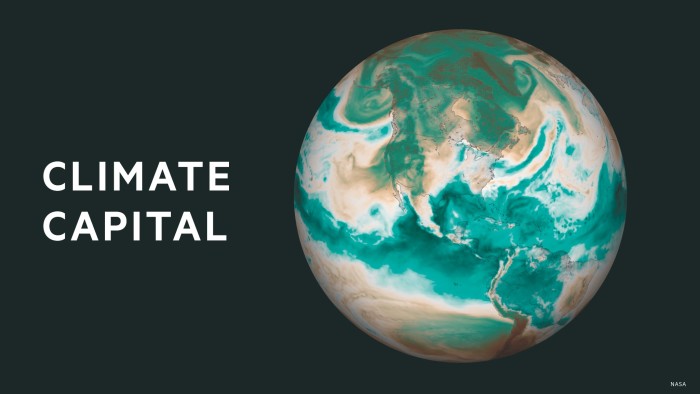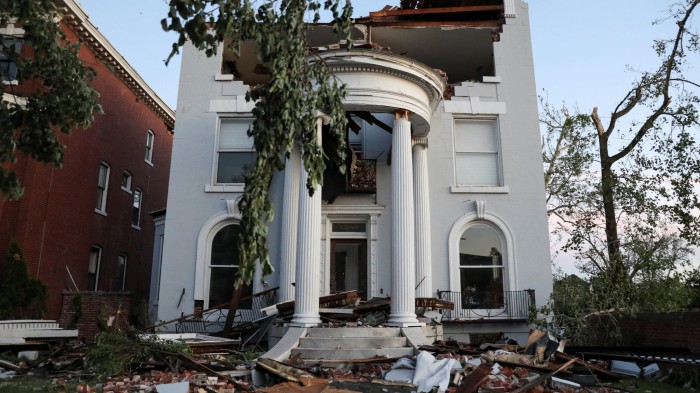Stay informed with free updates
Simply sign up to the Climate change myFT Digest — delivered directly to your inbox.
Climate-related disasters are raising the risk of home repossessions in the US and could cause billions of dollars in annual mortgage-related credit losses over the next decade, according to a new report by a risk-modelling group.
The report was released as the economic toll of the latest tornadoes that swept through Missouri and Kentucky, leaving at least 25 people dead and scores injured, was still being calculated.
Uninsured damage from flooding, as well as the depreciation of home values and rising insurance premiums from increasingly destructive climate disasters, could lead to as much as $1.2bn in credit losses in 2025, said risk-modelling group First Street.
It was estimated that mortgages on about 19,000 properties could be repossessed — or foreclosed, as the process is known in the US — this year due to climate risk.
That figure is estimated to rise to $5.4bn in losses from almost 84,000 repossessions by 2035, according to First Street calculations.
In 2024, lenders began the repossession process for about 253,000 properties in the US, according to real estate data company ATTOM.
“Mortgage markets are now on the front lines of climate risk,” said Jeremy Porter, First Street’s head of climate implications. “Our modelling demonstrates that physical hazards are already eroding foundational assumptions of loan underwriting, property valuation and credit servicing — introducing systemic financial risk,” he said.
Rising global temperatures are leading to more frequent and extreme weather events, such as storms, drought and flooding.
The increase in climate-related disasters is already driving insurance losses, which hit $320bn globally in 2024, according to Munich Re, the world’s largest reinsurance group.
In 2024, the US alone suffered damage costing at least $182.7bn as a result of extreme weather and climate disasters, according to the National Oceanic and Atmospheric Administration.
In response, private insurers have raised premiums, stopped underwriting new policies, or dropped coverage entirely in high-risk areas, such as locations in California and Florida, which experience higher than average policy non-renewal rates.
In turn, higher insurance premiums can lead to higher mortgage and credit card delinquency, according to a January report by the Federal Reserve Bank of Dallas.
These risks to a borrower’s creditworthiness — stemming from climate change — can ultimately “threaten household financial health and potentially impact the stability of the financial system”, wrote the bank authors.

In its report, First Street — which analysed how past wildfire, flooding and hurricane events affected repossession rates, as well as indirect factors such as insurance premiums and home prices — found that insurance coverage was a crucial factor in recovering from disasters and avoiding repossession.
For example, because standard homeowners insurance typically covers storm wind and wildfire damage, repossession rates were, in fact, lower for homes damaged by those types of disasters than those that were not because of insurance payouts, according to First Street.
In the case of some storms, federal emergency and disaster funding brought in another “influx of cash” to a community, added Porter.
Flood insurance, on the other hand, is often optional and costly. Many areas of the US are also not considered nationally designated “Special Flood Hazard Areas”, where federally backed mortgage holders are required to buy flood insurance. But in those areas, heavy rainfall can cause flooding, resulting in property damage.
This gap in flood insurance coverage leaves many properties exposed and is a major factor in increasing a homeowner’s risk of repossession, according to First Street.
Overall, a combination of financial stressors due to climate risks can amplify a borrower’s risk of defaulting, said the report, from high insurance premiums and broader economic strain to home equity losses from property value declines.
“We have this climate debt built up that we’re trying to correct for”, Porter told the Financial Times. “At this point, part of that is pricing risk properly so people know what they’re getting into when they buy their home.”
Climate Capital

Where climate change meets business, markets and politics. Explore the FT’s coverage here.
Are you curious about the FT’s environmental sustainability commitments? Find out more about our science-based targets here
Source link











